Hot Carrier Injection Reliability in Nanoscale Field Effect Transistors: Modeling and Simulation Methods
Abstract
1. Introduction
2. Modeling and Simulation Methods
2.1. HCI Simulation via Numerical Methods
2.1.1. Electro-Thermal Numerical Simulation
2.1.2. Temperature-Dependent Threshold Voltage Shift (TVS) Model
2.1.3. Simulation Results
2.2. Analytical HCI Model
2.2.1. Temperature Prediction via Thermal Equivalent Circuit
2.2.2. HCI Prediction
2.2.3. Application and Simulation Results
2.3. Trap-Based HCI Model
2.3.1. Trap Type in FinFET
2.3.2. Trap-Based HCD Model
2.4. Artificial Neural Network Model for HCI
2.4.1. Training Data
2.4.2. Results
3. Conclusions
Author Contributions
Funding
Institutional Review Board Statement
Informed Consent Statement
Data Availability Statement
Conflicts of Interest
References
- Thewes, R.; Weber, W. Effects of Hot-Carrier Degradation in Analog Cmos Circuits. Microelectron. Eng. 1997, 36, 285–292. [Google Scholar] [CrossRef]
- Acovic, A.; La Rosa, G.; Sun, Y.-C. A Review of Hot-Carrier Degradation Mechanisms in Mosfets. Microelectron. Reliab. 1996, 36, 845–869. [Google Scholar] [CrossRef]
- Alam, M.A.; Mahajan, B.K.; Chen, Y.-P.; Ahn, W.; Jiang, H.; Shin, S.H. A Device-to-System Perspective Regarding Self-Heating Enhanced Hot Carrier Degradation in Modern Field-Effect Transistors: A Topical Review. IEEE Trans. Electron Devices 2019, 66, 4556–4565. [Google Scholar] [CrossRef]
- Reddy, V.; Martin, S.; Benaissa, K.; Chancellor, C.; Bhatia, K.; Srinivasan, V.; Rentala, V.; Krishnan, S.; Ondrusek, J. Challenges in Radio Frequency and Mixed-Signal Circuit Reliability. In Proceedings of the 2019 IEEE International Electron Devices Meeting (IEDM), San Francisco, CA, USA, 7–11 December 2019. [Google Scholar]
- Leblebici, Y. Design Considerations for Cmos Digital Circuits with Improved Hot-Carrier Reliability. IEEE J. Solid-State Circuits 1996, 31, 1014–1024. [Google Scholar] [CrossRef]
- Gupta, A.; Gupta, C.; Jatana, H.; Dixit, A. Investigation of Hot-Carrier Degradation in 0.18-μ M Mosfets for the Evaluation of Device Lifetime and Digital Circuit Performance. IEEE Trans. Device Mater. Reliab. 2019, 19, 609–614. [Google Scholar] [CrossRef]
- Hu, C.; Tam, S.C.; Hsu, F.-C.; Ko, P.-K.; Chan, T.-Y.; Terrill, K.W. Hot-Electron-Induced Mosfet Degradation-Model, Monitor, and Improvement. IEEE J. Solid-State Circuits 1985, 20, 295–305. [Google Scholar]
- McMahon, W.; Hess, K. A Multi-Carrier Model for Interface Trap Generation. J. Comput. Electron. 2002, 1, 395–398. [Google Scholar] [CrossRef]
- Guérin, C.; Huard, V.; Bravaix, A. General Framework about Defect Creation at the Si/SiO2 Interface. J. Appl. Phys. 2009, 105, 114513. [Google Scholar] [CrossRef]
- Tyaginov, S.; Grasser, T. Modeling of Hot-Carrier Degradation: Physics and Controversial Issues. In Proceedings of the 2012 IEEE International Integrated Reliability Workshop Final Report, South Lake Tahoe, CA, USA, 14–18 October 2012. [Google Scholar]
- Randriamihaja, Y.M.; Huard, V.; Federspiel, X.; Zaka, A.; Palestri, P.; Rideau, D.; Roy, D.; Bravaix, A. Microscopic Scale Characterization and Modeling of Transistor Degradation under Hc Stress. Microelectron. Reliab. 2012, 52, 2513–2520. [Google Scholar] [CrossRef]
- Tyaginov, S.; Jech, M.; Franco, J.; Sharma, P.; Kaczer, B.; Grasser, T. Understanding and Modeling the Temperature Behavior of Hot-Carrier Degradation in Sion Nmosfets. IEEE Electron Device Lett. 2015, 37, 84–87. [Google Scholar] [CrossRef]
- Ng, K.; Taylor, G. Effects of Hot-Carrier Trapping in N-and P-Channel Mosfet’s. IEEE Trans. Electron Devices 1983, 30, 871–876. [Google Scholar] [CrossRef]
- Brunet, L.; Garros, X.; Bravaix, A.; Subirats, A.; Andrieu, F.; Weber, O.; Scheiblin, P.; Rafik, M.; Vincent, E.; Reimbold, G. Impact of Backside Interface on Hot Carriers Degradation of Thin Film Fdsoi Nmosfets. In Proceedings of the 2012 IEEE International Reliability Physics Symposium (IRPS), Anaheim, CA, USA, 15–19 April 2012. [Google Scholar]
- Kim, Y.; Kang, S.C.; Lee, S.K.; Jung, U.; Kim, S.M.; Lee, B.H. Hot-Carrier Instability of Nmosfets under Pseudorandom Bit Sequence Stress. IEEE Electron Device Lett. 2016, 37, 366–368. [Google Scholar] [CrossRef]
- Gupta, A.; Gupta, C.; Vega, R.A.; Hook, T.B.; Dixit, A. Reliability Modeling and Analysis of Hot-Carrier Degradation in Multiple-Fin Soi N-Channel Finfets with Self-Heating. IEEE Trans. Electron Devices 2019, 66, 2075–2080. [Google Scholar] [CrossRef]
- Mahapatra, S.; Sharma, U. A Review of Hot Carrier Degradation in N-Channel Mosfets—Part I: Physical Mechanism. IEEE Trans. Electron Devices 2020, 67, 2660–2671. [Google Scholar] [CrossRef]
- Ayala, N.; Martin-Martinez, J.; Amat, E.; Gonzalez, M.B.; Verheyen, P.; Rodriguez, R.; Nafria, M.; Aymerich, X.; Simoen, E. Nbti Related Time-Dependent Variability of Mobility and Threshold Voltage in Pmosfets and Their Impact on Circuit Performance. Microelectron. Eng. 2011, 88, 1384–1387. [Google Scholar] [CrossRef]
- Lorenz, D.; Georgakos, G.; Schlichtmann, U. Aging Analysis of Circuit Timing Considering Nbti and Hci. In Proceedings of the 2009 15th IEEE International On-Line Testing Symposium, Lisbon, Portugal, 24–26 June 2009. [Google Scholar]
- Fang, J.; Sapatnekar, S.S. Incorporating Hot-Carrier Injection Effects into Timing Analysis for Large Circuits. IEEE Trans. Very Large Scale Integr. Syst. 2014, 22, 2738–2751. [Google Scholar] [CrossRef]
- Wang, H.H.; Shieh, P.S.; Huang, C.T.; Tokami, K.; Kuo, R.; Chen, S.H.; Wei, H.C.; Pittikoun, S.; Aritome, S. A New Read-Disturb Failure Mechanism Caused by Boosting Hot-Carrier Injection Effect in Mlc Nand Flash Memory. In Proceedings of the 2009 IEEE International Memory Workshop, Monterey, CA, USA, 10–14 May 2009. [Google Scholar]
- Pouyan, P.; Amat, E.; Rubio, A. Reliability Challenges in Design of Memristive Memories. In Proceedings of the 2014 5th European Workshop on CMOS Variability (VARI), Palma de Mallorca, Spain, 29 September–1 October 2014. [Google Scholar]
- Goo, J.-S.; Kim, Y.-G.; L’Yee, H.; Kwon, H.-Y.; Shin, H. An Analytical Model for Hot-Carrier-Induced Degradation of Deep-Submicron N-Channel Ldd Mosfets. Solid-State Electron. 1995, 38, 1191–1196. [Google Scholar] [CrossRef]
- Rauch, S.E.; La Rosa, G. The Energy-Driven Paradigm of Nmosfet Hot-Carrier Effects. IEEE Trans. Device Mater. Reliab. 2005, 5, 701–705. [Google Scholar] [CrossRef]
- Bina, M.; Tyaginov, S.; Franco, J.; Rupp, K.; Wimmer, Y.; Osintsev, D.; Kaczer, B.; Grasser, T. Predictive Hot-Carrier Modeling of N-Channel Mosfets. IEEE Trans. Electron Devices 2014, 61, 3103–3110. [Google Scholar] [CrossRef]
- Chen, W.; Cheng, R.; Wang, D.-W.; Song, H.; Wang, X.; Chen, H.; Li, E.; Yin, W.-Y.; Zhao, Y. Electrothermal Effects on Hot-Carrier Reliability in Soi Mosfets—Ac Versus Circuit-Speed Random Stress. IEEE Trans. Electron Devices 2016, 63, 3669–3676. [Google Scholar] [CrossRef]
- Zhang, P.; Chen, W.; Hu, J.; Yin, W.-Y. Electrothermal Effects on Hot Carrier Injection in N-Type Soi Finfet under Circuit-Speed Bias. IEEE Trans. Electron Devices 2017, 64, 3802–3807. [Google Scholar] [CrossRef]
- Jiang, H.; Shin, S.; Liu, X.; Zhang, X.; Alam, M.A. The Impact of Self-Heating on Hci Reliability in High-Performance Digital Circuits. IEEE Electron Device Lett. 2017, 38, 430–433. [Google Scholar] [CrossRef]
- Yu, Z.; Zhang, J.; Wang, R.; Guo, S.; Liu, C.; Huang, R. New Insights into the Hot Carrier Degradation (Hcd) in Finfet: New Observations, Unified Compact Model, and Impacts on Circuit Reliability. In Proceedings of the 2017 IEEE International Electron Devices Meeting (IEDM), San Francisco, CA, USA, 2–6 December 2017. [Google Scholar]
- Yu, Z.; Zhang, Z.; Sun, Z.; Wang, R.; Huang, R. On the Trap Locations in Bulk Finfets after Hot Carrier Degradation (Hcd). IEEE Trans. Electron Devices 2020, 67, 3005–3009. [Google Scholar] [CrossRef]
- Wang, R.; Sun, Z.; Liu, Y.Y.; Yu, Z.; Wang, Z.; Jiang, X.; Huang, R. Understanding Hot Carrier Reliability in Finfet Technology from Trap-Based Approach. In Proceedings of the 2021 IEEE International Electron Devices Meeting (IEDM), San Francisco, CA, USA, 11–16 December 2021. [Google Scholar]
- Sharma, U.; Mahapatra, S. A Spice Compatible Compact Model for Hot-Carrier Degradation in Mosfets under Different Experimental Conditions. IEEE Trans. Electron Devices 2018, 66, 839–846. [Google Scholar] [CrossRef]
- Wang, Y.; Li, E.; Duan, H.; Tian, L.; Zang, W.; Min, Q.; Chen, W. An Artificial Neural Network Model for Electro-Thermal Effect Affected Hot Carrier Injection Reliability in 14-Nm Finfets. IEEE Trans. Microw. Theory Tech. 2022, 1–8. [Google Scholar] [CrossRef]
- Ancona, M.G.; Saks, N.S.; McCarthy, D. Lateral Distribution of Hot-Carrier-Induced Interface Traps in Mosfets. IEEE Trans. Electron Devices 1988, 35, 2221–2228. [Google Scholar] [CrossRef]
- Amat, E.; Kauerauf, T.; Degraeve, R.; Rodríguez, R.; Nafría, M.; Aymerich, X.; Groeseneken, G. Channel Hot-Carrier Degradation in Pmos and Nmos Short Channel Transistors with High-K Dielectric Stack. Microelectron. Eng. 2010, 87, 47–50. [Google Scholar] [CrossRef]
- Wu, Q.; Bayerl, A.; Porti, M.; Martin-Martínez, J.; Lanza, M.; Rodriguez, R.; Velayudhan, V.; Nafria, M.; Aymerich, X.; Gonzalez, M.B.; et al. A Conductive Afm Nanoscale Analysis of Nbti and Channel Hot-Carrier Degradation in Mosfets. IEEE Trans. Electron Devices 2014, 61, 3118–3124. [Google Scholar] [CrossRef]
- Bayer, A.; Porti, M.; Martin-Martínez, J.; Lanza, M.; Rodriguez, R.; Velayudhan, V.; Amat, E.; Nafria, M.; Aymerich, X.; Gonzalez, M.B.; et al. Channel Hot-Carriers Degradation in Mosfets: A Conductive Afm Study at the Nanoscale. In Proceedings of the 2013 IEEE International Reliability Physics Symposium (IRPS), Monterey, CA, USA, 14–18 April 2013. [Google Scholar]
- Laurent, A.; Garros, X.; Barraud, S.; Mariniello, G.; Reimbold, G.; Roy, D.; Vincent, E.; Ghibaudo, G. Hot Carrier Degradation in Nanowire Transistors: Physical Mechanisms, Width Dependence and Impact of Self-Heating. In Proceedings of the 2016 IEEE Symposium on VLSI Technology, Honolulu, HI, USA, 14–16 June 2016. [Google Scholar]
- Vandemaele, M.; Kaczer, B.; Tyaginov, S.; Bury, E.; Chasin, A.; Franco, J.; Makarov, A.; Mertens, H.; Hellings, G.; Groeseneken, G. Simulation Comparison of Hot-Carrier Degradation in Nanowire, Nanosheet and Forksheet Fets. In Proceedings of the 2022 IEEE International Reliability Physics Symposium (IRPS), Dallas, TX, USA, 27–31 March 2022. [Google Scholar]
- Chasin, A.; Bury, E.; Kaczer, B.; Franco, J.; Roussel, P.; Ritzenthaler, R.; Mertens, H.; Horiguchi, N.; Linten, D.; Mocuta, A. Complete Degradation Mapping of Stacked Gate-All-around Si Nanowire Transistors Considering Both Intrinsic and Extrinsic Effects. In Proceedings of the 2017 IEEE International Electron Devices Meeting (IEDM), San Francisco, CA, USA, 2–6 December 2017. [Google Scholar]
- Cheng, R.; Yu, X.; Shen, L.; Yin, L.; Zhang, Y.; Zheng, Z.; Chen, B.; Liu, X.; Zhao, Y. Ultrafast Pulse Characterization of Hot Carrier Injection Effects on Ballistic Carrier Transport for Sub-100 Nm Mosfets. In Proceedings of the 2017 IEEE International Reliability Physics Symposium (IRPS), Monterey, CA, USA, 2–6 April 2017. [Google Scholar]
- Qu, Y.; Lin, X.; Li, J.; Cheng, R.; Yu, X.; Zheng, Z.; Lu, J.; Chen, B.; Zhao, Y. Ultra Fast (<1 Ns) Electrical Characterization of Self-Heating Effect and Its Impact on Hot Carrier Injection in 14nm Finfets. In Proceedings of the 2017 IEEE International Electron Devices Meeting (IEDM), San Francisco, CA, USA, 2–6 December 2017. [Google Scholar]
- Jiang, H.; Liu, X.; Xu, N.; He, Y.; Du, G.; Zhang, X. Investigation of Self-Heating Effect on Hot Carrier Degradation in Multiple-Fin Soi Finfets. IEEE Electron Device Lett. 2015, 36, 1258–1260. [Google Scholar] [CrossRef]
- Hsu, F.-C.; Chiu, K.-Y. Temperature Dependence of Hot-Electron-Induced Degradation in Mosfet’s. IEEE Electron Device Lett. 1984, 5, 148–150. [Google Scholar] [CrossRef]
- Heremans, P.; Van den Bosch, G.; Bellens, R.; Groeseneken, G.; Maes, H. Understanding of the Temperature Dependence of Channel Hot-Carrier Degradation in the Range 77 K to 300 K. In Proceedings of the International Technical Digest on Electron Devices Meeting, Washington, DC, USA, 3–6 December 1989. [Google Scholar]
- Acovic, A.; Dutoit, M.; Ilegems, M. A Study of the Increased Effects of Hot-Carrier Stress on Nmosfets at Low Temperature. IEEE Trans. Electron Devices 1989, 36, 2603. [Google Scholar] [CrossRef]
- Heremans, P.; Van Den Bosch, G.; Bellens, R.; Groeseneken, G.; Maes, H.E. Temperature Dependence of the Channel Hot-Carrier Degradation of N-Channel Mosfet’s. IEEE Trans. Electron Devices 1990, 37, 980–993. [Google Scholar] [CrossRef]
- Song, M.; MacWilliams, K.P.; Woo, J.C. Comparison of Nmos and Pmos Hot Carrier Effects from 300 to 77 K. IEEE Trans. Electron Devices 1997, 44, 268–276. [Google Scholar] [CrossRef]
- Guérin, C.; Huard, V.; Bravaix, A. The Energy-Driven Hot-Carrier Degradation Modes of Nmosfets. IEEE Trans. Device Mater. Reliab. 2007, 7, 225–235. [Google Scholar] [CrossRef]
- Bravaix, A.; Guérin, C.; Huard, V.; Roy, D.; Roux, J.-M.; Vincent, E. Hot-Carrier Acceleration Factors for Low Power Management in Dc-Ac Stressed 40 nm Nmos Node at High Temperature. In Proceedings of the 2009 IEEE International Reliability Physics Symposium, Montreal, QC, Canada, 26–30 April 2009. [Google Scholar]
- Aminzadeh, P.; Alavi, M.; Scharfetter, D. Temperature Dependence of Substrate Current and Hot Carrier-Induced Degradation at Low Drain Bias. In Proceedings of the 1998 Symposium on VLSI Technology Digest of Technical Papers (Cat. No. 98CH36216), Honolulu, HI, USA, 9–11 June 1998. [Google Scholar]
- Amat, E.; Kauerauf, T.; Degraeve, R.; Rodriguez, R.; Nafria, M.; Aymerich, X.; Groeseneken, G. Competing Degradation Mechanisms in Short-Channel Transistors under Channel Hot-Carrier Stress at Elevated Temperatures. IEEE Trans. Device Mater. Reliab. 2009, 9, 454–458. [Google Scholar] [CrossRef]
- Pop, E.; Sinha, S.; Goodson, K.E. Heat Generation and Transport in Nanometer-Scale Transistors. Proc. IEEE 2006, 94, 1587–1601. [Google Scholar] [CrossRef]
- Chaudhry, A.; Kumar, M.J. Controlling Short-Channel Effects in Deep-Submicron Soi Mosfets for Improved Reliability: A Review. IEEE Trans. Device Mater. Reliab. 2004, 4, 99–109. [Google Scholar] [CrossRef]
- Jurczak, M.; Collaert, N.; Veloso, A.; Hoffmann, T.; Biesemans, S. Review of Finfet Technology. In Proceedings of the 2009 IEEE International SOI Conference, Foster City, CA, USA, 5–8 October 2009. [Google Scholar]
- Mishra, P.; Muttreja, A.; Jha, N.K. Finfet Circuit Design. In Nanoelectronic Circuit Design; Springer: New York, NY, USA, 2011. [Google Scholar]
- Sinha, S.; Yeric, G.; Chandra, V.; Cline, B.; Cao, Y. Exploring Sub-20nm Finfet Design with Predictive Technology Models. In Proceedings of the DAC Design Automation Conference 2012, San Francisco, CA, USA, 3–7 June 2012. [Google Scholar]
- Liu, W.; Asheghi, M. Thermal Conductivity Measurements of Ultra-Thin Single Crystal Silicon Layers. J. Heat Transf. 2005, 128, 75–83. [Google Scholar] [CrossRef]
- Scholten, A.; Smit, G.; Pijper, R.; Tiemeijer, L.; Tuinhout, H.; Van der Steen, J.-L.; Mercha, A.; Braccioli, M.; Klaassen, D. Experimental Assessment of Self-Heating in Soi Finfets. In Proceedings of the 2009 IEEE International Electron Devices Meeting (IEDM), Baltimore, MD, USA, 7–9 December 2009. [Google Scholar]
- Liu, S.; Wang, J.; Lu, Y.; Huang, D.; Huang, C.; Hsieh, W.; Lee, J.; Tsai, Y.; Shih, J.; Lee, Y.-H. Self-Heating Effect in Finfets and Its Impact on Devices Reliability Characterization. In Proceedings of the 2014 IEEE International Reliability Physics Symposium, Waikoloa, HI, USA, 1–5 June 2014. [Google Scholar]
- Jang, D.; Bury, E.; Ritzenthaler, R.; Bardon, M.G.; Chiarella, T.; Miyaguchi, K.; Raghavan, P.; Mocuta, A.; Groeseneken, G.; Mercha, A. Self-Heating on Bulk Finfet from 14nm Down to 7nm Node. In Proceedings of the 2015 IEEE International Electron Devices Meeting (IEDM), Washington, DC, USA, 7–9 December 2015. [Google Scholar]
- Fiegna, C.; Yang, Y.; Sangiorgi, E.; O’Neill, A.G. Analysis of Self-Heating Effects in Ultrathin-Body Soi Mosfets by Device Simulation. IEEE Trans. Electron Devices 2007, 55, 233–244. [Google Scholar] [CrossRef]
- Jiang, H.; Shin, S.; Liu, X.; Zhang, X.; Alam, M.A. Characterization of Self-Heating Leads to Universal Scaling of Hci Degradation of Multi-Fin Soi Finfets. In Proceedings of the 2016 IEEE International Reliability Physics Symposium (IRPS), Pasadena, CA, USA, 17–21 April 2016. [Google Scholar]
- Chen, W.; Yin, W.-Y.; Li, E.; Cheng, M.; Guo, J. Electrothermal Investigation on Vertically Aligned Single-Walled Carbon Nanotube Contacted Phase-Change Memory Array for 3-D Ics. IEEE Trans. Electron Devices 2015, 62, 3258–3263. [Google Scholar] [CrossRef]
- Chen, W.; Guo, J. Performance Analysis of Carbon Nanotube Contacted Phase Change Memory by Finite Element Method. J. Appl. Phys. 2011, 110, 084315. [Google Scholar] [CrossRef]
- Kwon, Y.W.; Bang, H. The Finite Element Method Using Matlab; CRC Press: Boca Raton, FL, USA, 2018. [Google Scholar]
- Xu, C.; Kolluri, S.K.; Endo, K.; Banerjee, K. Analytical Thermal Model for Self-Heating in Advanced Finfet Devices with Implications for Design and Reliability. IEEE Trans. Comput.-Aided Des. Integr. Circuits Syst. 2013, 32, 1045–1058. [Google Scholar] [CrossRef]
- Sun, J.; Li, X.; Sun, Y.; Shi, Y. Impact of Geometry, Doping, Temperature, and Boundary Conductivity on Thermal Characteristics of 14-Nm Bulk and Soi Finfets. IEEE Trans. Device Mater. Reliab. 2020, 20, 119–127. [Google Scholar] [CrossRef]
- Venkateswarlu, S.; Sudarsanan, A.; Singh, S.G.; Nayak, K. Ambient Temperature-Induced Device Self-Heating Effects on Multi-Fin Si N-Finfet Performance. IEEE Trans. Electron Devices 2018, 65, 2721–2728. [Google Scholar] [CrossRef]
- Zhang, X.; Connelly, D.; Takeuchi, H.; Hytha, M.; Mears, R.J.; Liu, T.-J.K. Comparison of Soi Versus Bulk Finfet Technologies for 6t-Sram Voltage Scaling at the 7-/8-Nm Node. IEEE Trans. Electron Devices 2016, 64, 329–332. [Google Scholar] [CrossRef]
- Takeda, E.; Suzuki, N. An Empirical Model for Device Degradation Due to Hot-Carrier Injection. IEEE Electron Device Lett. 1983, 4, 111–113. [Google Scholar] [CrossRef]
- Yu, Z.; Wang, R.; Hao, P.; Guo, S.; Ren, P.; Huang, R. Non-Universal Temperature Dependence of Hot Carrier Degradation (Hcd) in Finfet: New Observations and Physical Understandings. In Proceedings of the 2018 IEEE 2nd Electron Devices Technology and Manufacturing Conference (EDTM), Kobe, Japan, 13–16 March 2018. [Google Scholar]
- Yu, Z.; Sun, Z.; Wang, R.; Zhang, J.; Huang, R. Hot Carrier Degradation-Induced Dynamic Variability in Finfets: Experiments and Modeling. IEEE Trans. Electron Devices 2020, 67, 1517–1522. [Google Scholar] [CrossRef]
- Yang, C.; Chen, S.; Tsai, Y.; Lu, R.; Lee, Y.-H. The Physical Mechanism Investigation between Hk/Il Gate Stack Breakdown and Time-Dependent Oxygen Vacancy Trap Generation in Finfet Devices. In Proceedings of the 2016 IEEE International Reliability Physics Symposium (IRPS), Pasadena, CA, USA, 17–21 April 2016. [Google Scholar]
- Chen, X.; Wei, Z.; Li, M.; Rocca, P. A Review of Deep Learning Approaches for Inverse Scattering Problems (Invited Review). Prog. Electromagn. Res. 2020, 167, 67–81. [Google Scholar] [CrossRef]
- Wang, F.; Devabhaktuni, V.K.; Xi, C.; Zhang, Q.J. Neural Network Structures and Training Algorithms for Rf and Microwave Applications. Int. J. RF Microw. Comput.-Aided Eng. 1999, 9, 216–240. [Google Scholar] [CrossRef]
- Zhang, Q.-J.; Gupta, K.C.; Devabhaktuni, V.K. Artificial Neural Networks for Rf and Microwave Design-from Theory to Practice. IEEE Trans. Microw. Theory Tech. 2003, 51, 1339–1350. [Google Scholar] [CrossRef]
- Gabr, A.M.; Featherston, C.; Zhang, C.; Bonfil, C.; Zhang, Q.-J.; Smy, T.J. Design and Optimization of Optical Passive Elements Using Artificial Neural Networks. J. Opt. Soc. Am. B 2019, 36, 999–1007. [Google Scholar] [CrossRef]
- Marinković, Z.; Crupi, G.; Caddemi, A.; Marković, V.; Schreurs, D.M.P. A Review on the Artificial Neural Network Applications for Small-Signal Modeling of Microwave Fets. Int. J. Numer. Model. Electron. Netw. Devices Fields 2020, 33, e2668. [Google Scholar] [CrossRef]
- Marinković, Z.; Crupi, G.; Schreurs, D.M.-P.; Caddemi, A.; Marković, V. Microwave Finfet Modeling Based on Artificial Neural Networks Including Lossy Silicon Substrate. Microelectron. Eng. 2011, 88, 3158–3163. [Google Scholar] [CrossRef]
- Marinković, Z.; Crupi, G.; Schreurs, D.M.-P.; Caddemi, A.; Marković, V. Artificial Neural Network Based Modeling of Finfet Forward Transmission Coefficient. In Proceedings of the 2011 10th International Conference on Telecommunication in Modern Satellite Cable and Broadcasting Services (TELSIKS), Nis, Serbia, 5–8 October 2011. [Google Scholar]
- Marinković, Z.; Crupi, G.; Schreurs, D.M.P.; Caddemi, A.; Marković, V. Multibias Neural Modeling of Fin Field-Effect Transistor Admittance Parameters. Microw. Opt. Technol. Lett. 2012, 54, 2082–2088. [Google Scholar] [CrossRef]
- Crupi, G.; Schreurs, D.M.-P.; Raskin, J.-P.; Caddemi, A. A Comprehensive Review on Microwave Finfet Modeling for Progressing Beyond the State of Art. Solid-State Electron. 2013, 80, 81–95. [Google Scholar] [CrossRef]
- Kingma, D.P.; Ba, J. Adam: A Method for Stochastic Optimization. arXiv 2014, arXiv:1412.6980. [Google Scholar]
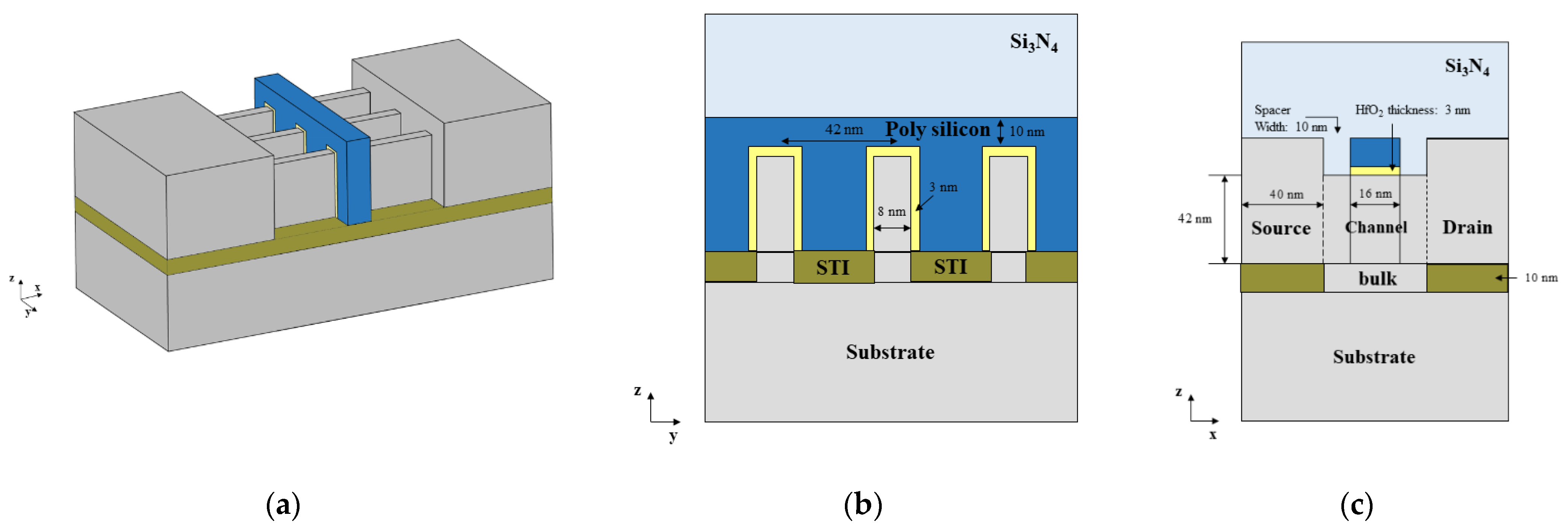
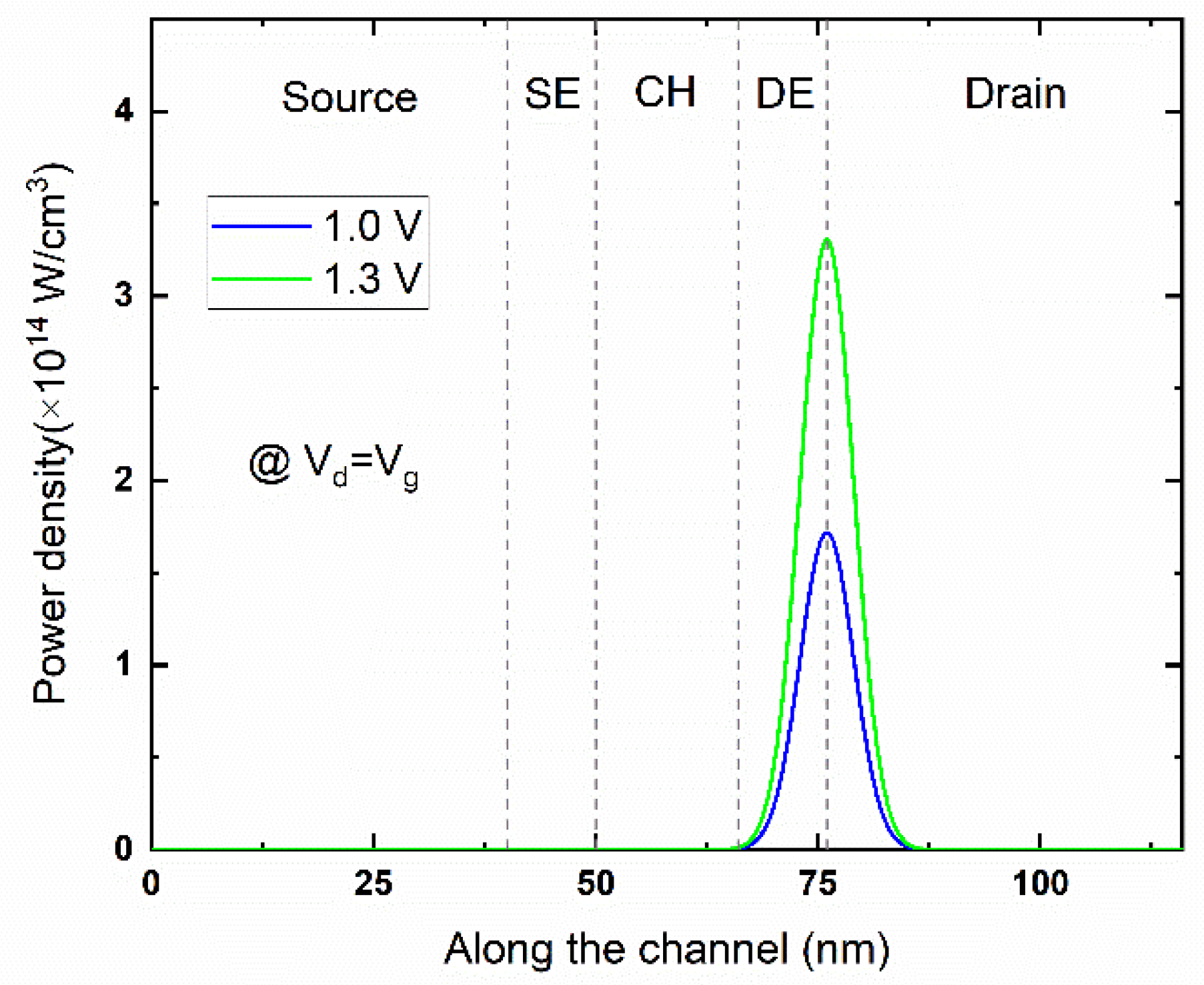



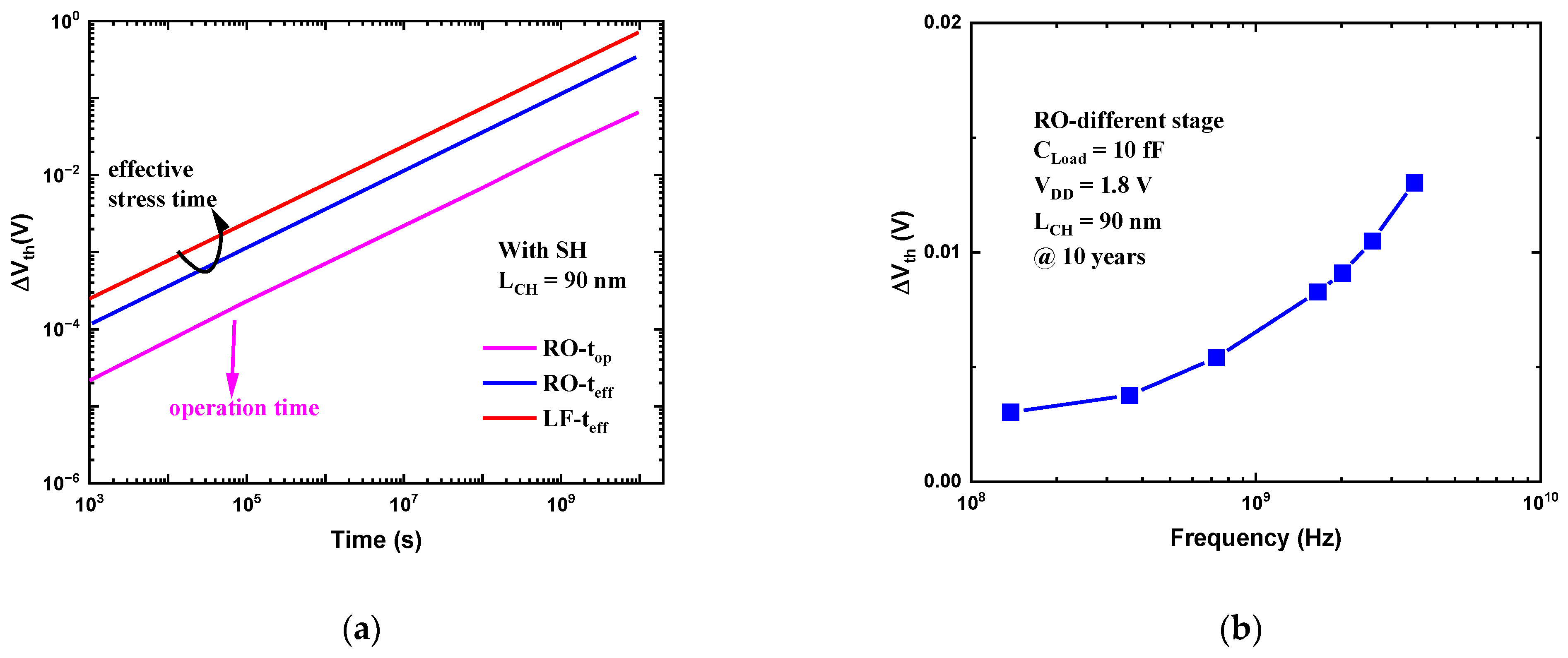

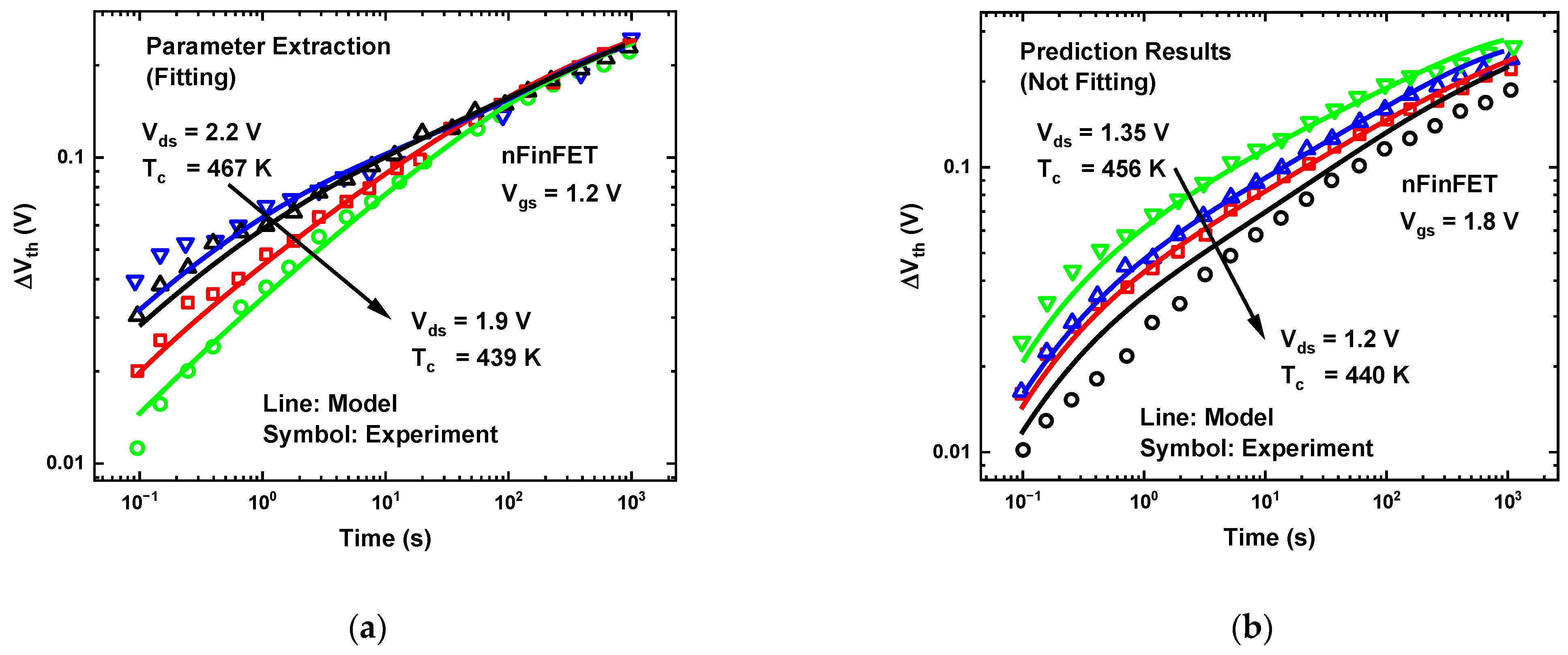
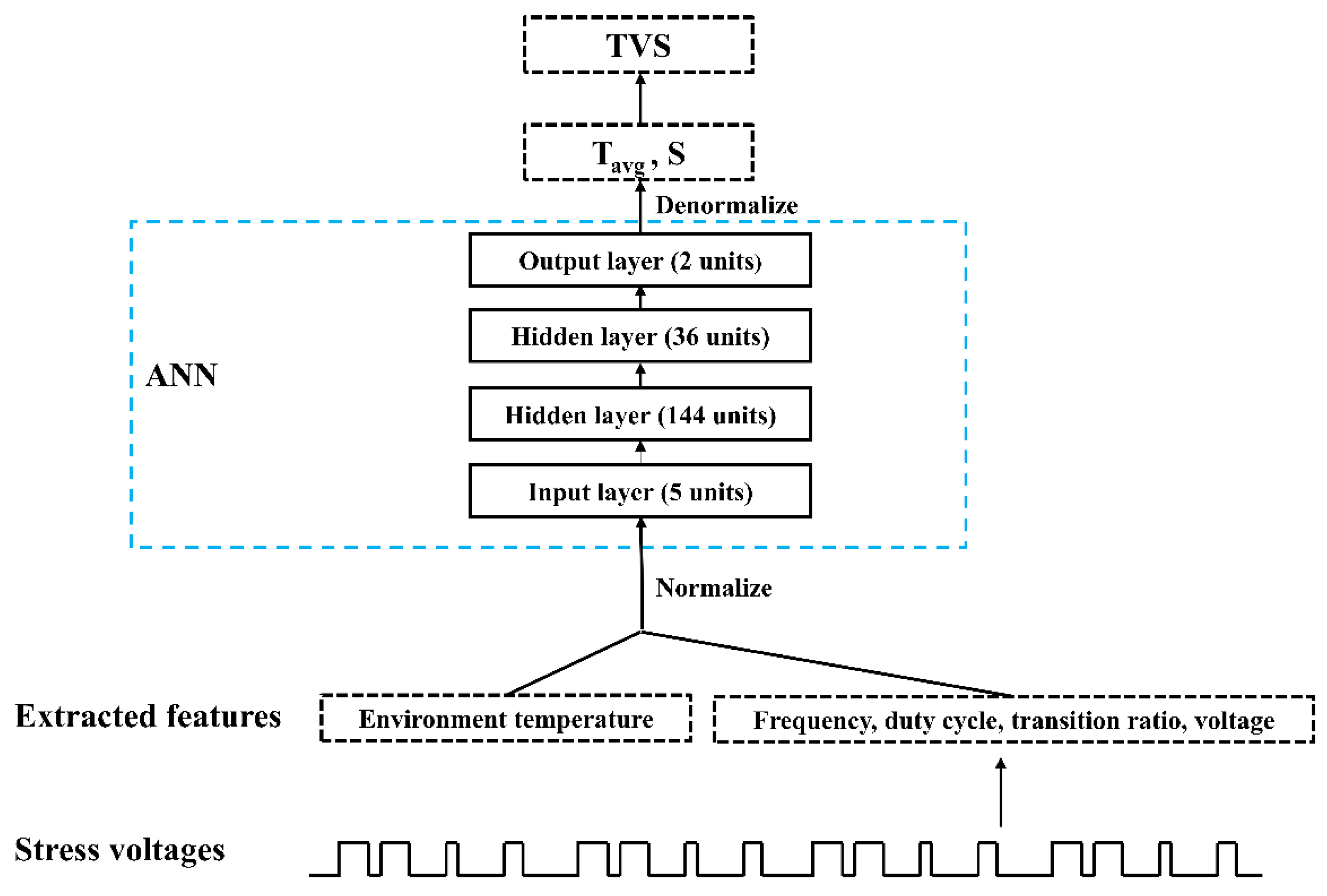
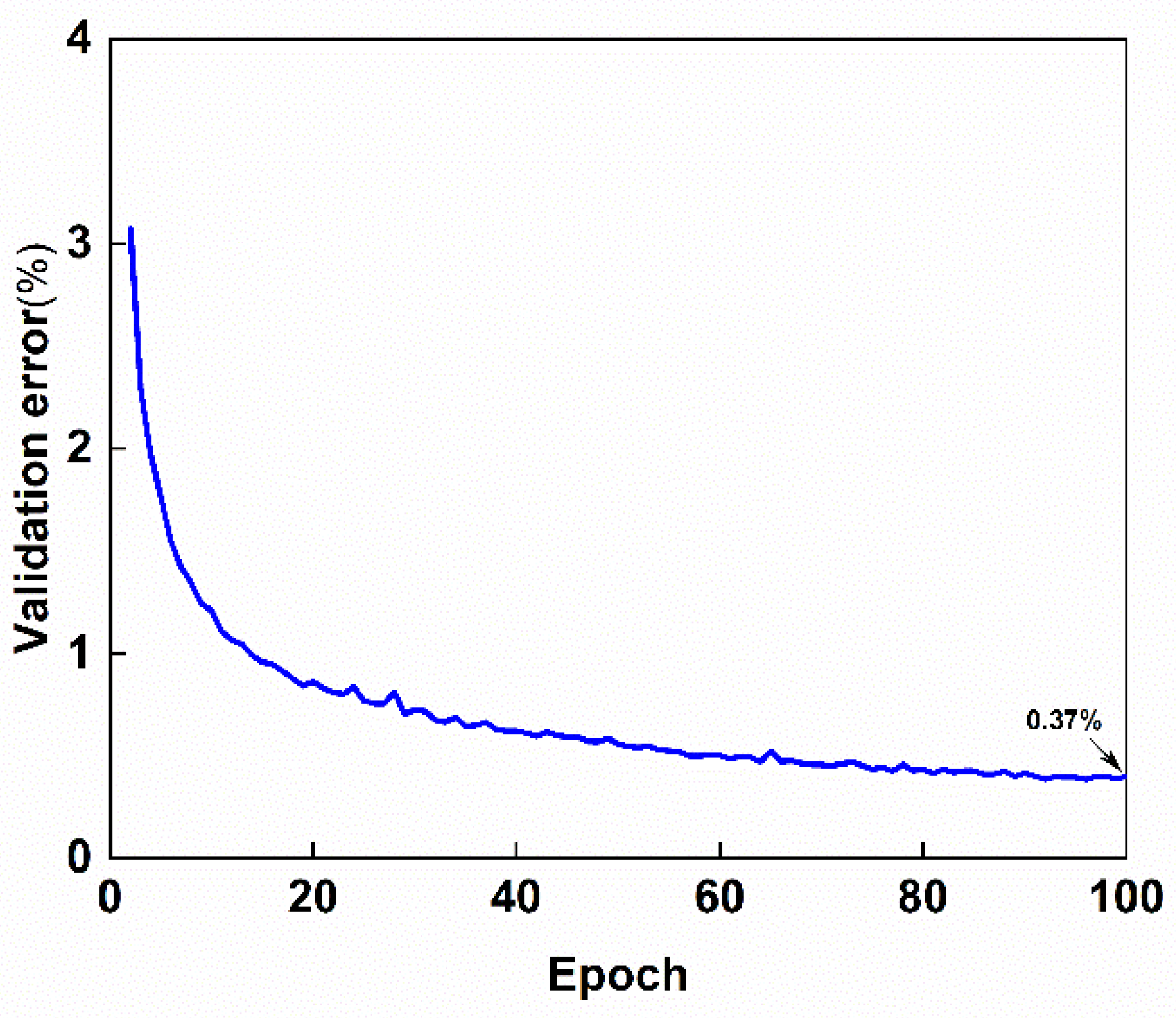

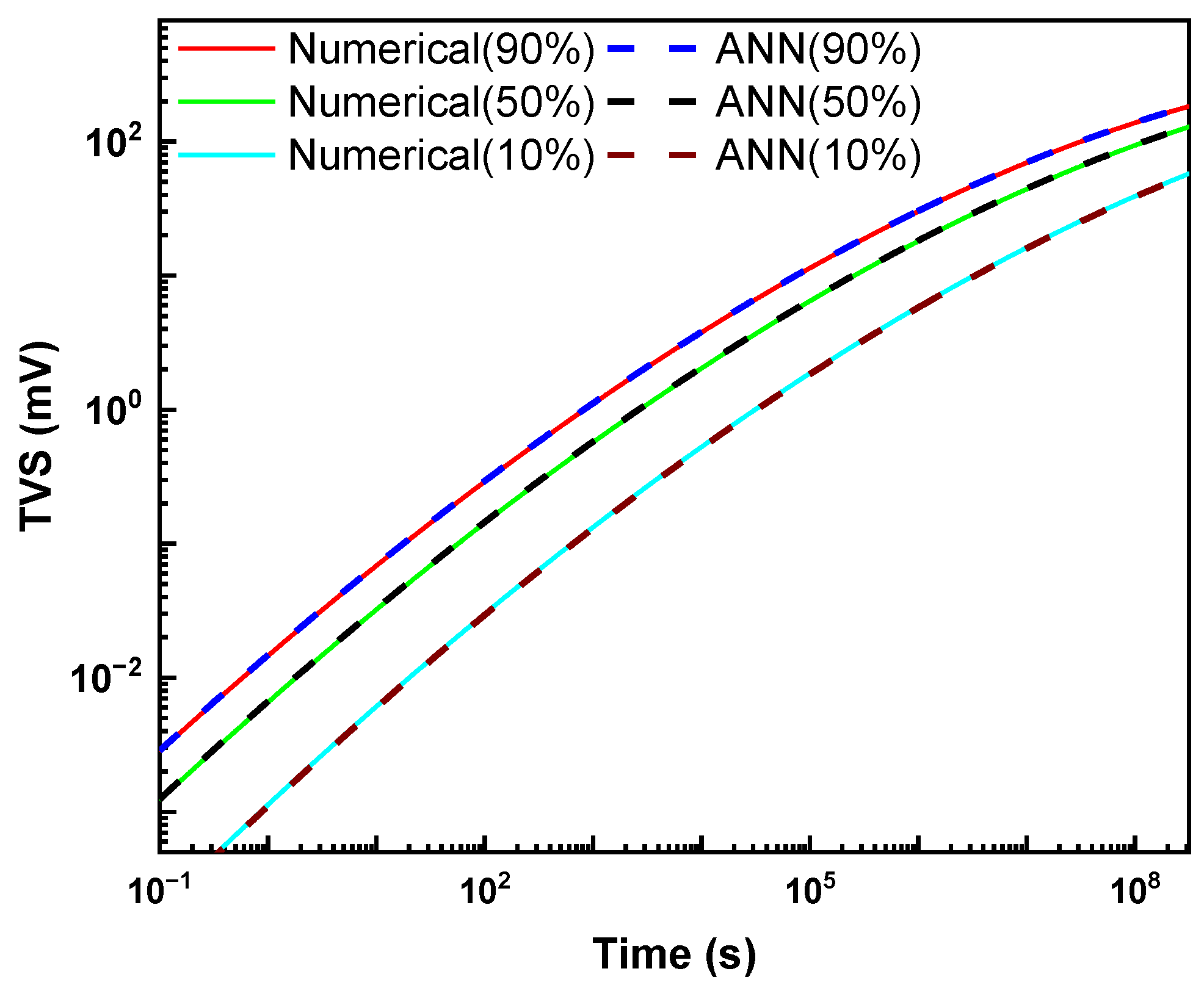
Publisher’s Note: MDPI stays neutral with regard to jurisdictional claims in published maps and institutional affiliations. |
© 2022 by the authors. Licensee MDPI, Basel, Switzerland. This article is an open access article distributed under the terms and conditions of the Creative Commons Attribution (CC BY) license (https://creativecommons.org/licenses/by/4.0/).
Share and Cite
Wang, Y.; Li, Y.; Yang, Y.; Chen, W. Hot Carrier Injection Reliability in Nanoscale Field Effect Transistors: Modeling and Simulation Methods. Electronics 2022, 11, 3601. https://doi.org/10.3390/electronics11213601
Wang Y, Li Y, Yang Y, Chen W. Hot Carrier Injection Reliability in Nanoscale Field Effect Transistors: Modeling and Simulation Methods. Electronics. 2022; 11(21):3601. https://doi.org/10.3390/electronics11213601
Chicago/Turabian StyleWang, Yimin, Yun Li, Yanbin Yang, and Wenchao Chen. 2022. "Hot Carrier Injection Reliability in Nanoscale Field Effect Transistors: Modeling and Simulation Methods" Electronics 11, no. 21: 3601. https://doi.org/10.3390/electronics11213601
APA StyleWang, Y., Li, Y., Yang, Y., & Chen, W. (2022). Hot Carrier Injection Reliability in Nanoscale Field Effect Transistors: Modeling and Simulation Methods. Electronics, 11(21), 3601. https://doi.org/10.3390/electronics11213601






